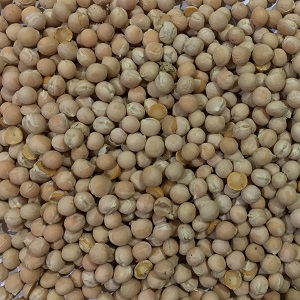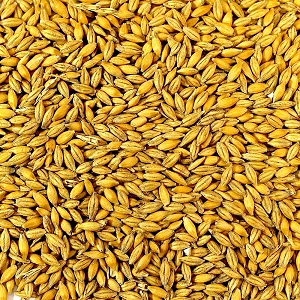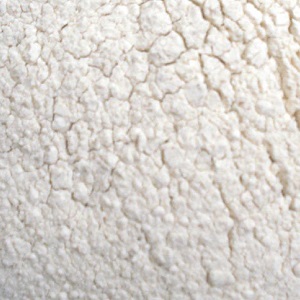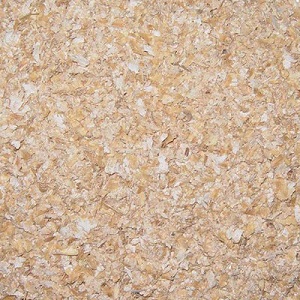Description
Peas (usually Pisum sativum L.) are one of the four most important legume crops next to soybean, groundnut, and beans. It is a particularly important legume grain in temperate areas with numerous food (dry seed, vegetable) and feed (seed, fodder) usages (Muehlbauer et al., 1997).
Peas are a fast-growing herbaceous legume with angular or roundish hollow stems covered with a waxy bloom. The plant has a tap root that can grow as deep as 1 m, with numerous lateral roots. Leaves are alternate, compound with 1-3 pairs of leaflets borne on petioles with several pairs of tendrils. Large (up to 10 cm long) leaf-like stipules are inserted at the base of the leaves (FAO, 2011; Muehlbauer et al., 1997; Oelke et al., 1991). The inflorescence is a raceme that bears white, pink or purple flowers. The colour of the flower is an indicator of tannin content in the seed: white-flowered peas produce tannin-free seeds while the seeds of coloured-flowered peas contain tannins (Prolea, 2008). Pods are dehiscent and contain several seeds that may be globose or angled, smooth or wrinkled (FAO, 2011; Muehlbauer et al., 1997).
Pisum sativum has a large genetic diversity and breeding programmes have generated many varieties. There are winter and spring varieties, leafy and leafless, early- or late-maturing, etc. Seeds can be green, yellow or pale green, brown or mottled, thin- or thick-hulled, smooth or wrinkled, of varying shape and size. Some varieties are tannin-free and pea breeding offers a large opportunity to improve the nutritional characteristics of the grain (Hickling, 2003; Gatel et al., 1990; Canbolat et al., 2007; Kosev et al., 2010).
Pea seeds are a protein and energy feed. Peas are regarded as a highly valuable protein source for animal nutrition due to their high protein content (usually about 22-24%, ranging between 16-32% DM), which is intermediate between cereals and oil meals (Castell et al., 1996; Feedipedia, 2011). The protein content tends to be higher for winter peas than for spring peas, and lower in smooth seeds than in wrinkled ones (Gatel et al., 1990).
Peas can be an alternative to soybean meal. Their amino-acid profile is well-balanced in lysine (similar to that of soybean meal and higher than those of cereal grains, particularly maize grain) so that they can be a protein supplement in cereal-based diets (Duranti et al., 1997). However, they are deficient in tryptophan and sulphur-containing amino-acids (notably methionine) for species where these are essential amino-acids (Dixon et al., 1992; Gatel, 1995; Perrot, 1995; Vander Pol et al., 2008). Peas can be a particularly valuable protein source in organic livestock farming when usual sources such as soybean meal and industrial amino-acids are prohibited, for instance due to concerns regarding GMOs (Schumacher et al., 2011; Martini et al., 2008).
It should be noted that given the extent of different cultivars grown and seed types produced, there is a considerable range in the composition and, consequently, nutritive value of peas (Castell et al., 1996).
Peas also have a high starch content (48-54% DM) though some varieties, such as the marrowfat peas used in the United Kingdom, can have less than 45% DM as starch (Feedipedia, 2011). Spring peas and smooth peas contain more starch than winter and wrinkled peas respectively (Gatel et al., 1990). Pea seeds are relatively low in fibre (NDF 10-18% DM; ADF 6-8% DM; ADL less than 0.5% DM) and oil (less than 1.5% DM) (Feedipedia, 2011).
Contents in tannins and trypsin inhibitors depend on the variety. Protein peas have particularly low levels of antitryptic activity (2-6 TIU/mg), very low levels of tannins and a higher protein content (23-24% DM) (GNIS, 2011).
Pea seeds are an excellent binder for pelleting or cubing (Anderson et al., 2002). They have a positive effect on pellet quality, with a index of 6 (on a 10 scale according to Thomas et al., 2001), higher than the indices of 5, 5 and 4 for barley, maize and soybean meal respectively.
Ruminants
Pea seeds are a dual purpose ingredient. They provide half as much as crude protein as soybean meal with a lower rumen undegradable protein content, with the high energy value of a starch-rich feed (Schroeder, 2002). It represents one of the best quality and least expensive feeds, its low cost partly reflecting the low cost of transportation (Anderson et al., 2002).
Peas have a low starch degradation rate (from 4 to 6%/hour) that is much slower than that of cereals, such as barley (21 to 34%/h). This low rate decreases the risk of acidosis with high starch diets, as the pH lowest point is higher than that observed with barley when fed at a level of 70% with oaten hay (Valentine et al., 1987).
Palatability
Pea seeds are highly palatable to ruminants (Hutson et al., 1981).
Beef cattle
As peas are very palatable, they are best used in diets where nutrient density and palatability are important, such as creep feeds where its optimum inclusion rate lies between 33 and 67% (Anderson et al., 2002). Peas can replace a mixture of barley and canola meal for young calves (Schroeder, 2002). They can also be used as an ingredient in creep feed to increase calf weight gain without impairing rumen fermentation and digestion (Gelvin et al., 2004).
For growing steers and heifers, peas should not constitute more than 25% of the total diet to prevent excessive protein intake (Anderson et al., 2002). It is a suitable supplement to maize silage for growing cattle (Gatel, 1995). At a level of 20% in a total mixed ration fed ad libitum, replacement of a maize grain and rapeseed meal diet by field peas increased DM intake without impairing fermentation characteristics: pH and NH3 concentration remained unchanged, and total volatile fatty acids and acetate concentration decreased. Nevertheless, average daily gain increased due to the increase in DMI (Gilbery et al., 2007). These results indicate that field peas can be included successfully into rations at levels up to 36% (diet DM) without negatively affecting growth and most carcass characteristics of finishing beef cattle (though effects on marbling score were variable). These data also indicate that the energy content of field peas is similar to that of cereal grains, such as maize and barley, when included in high-concentrate finishing diets (Lardy et al., 2009).
Feeding peas to steers results in growth and carcass characteristics similar to that obtained with dry-rolled maize, and improves objective and subjective tenderness, overall desirability and flavour of beef. Field peas could be fed to cattle and give positive attributes to the quality of the meat up to 30% inclusion in the diet (Jenkins et al., 2011).
Pigs
Peas are a good source of energy and protein for pigs, and as such is the grain legume most used for pig feeding in Europe and Canada. Because of the large variability in nutrient composition and anti-nutritional factors in peas, it is recommended to characterize the raw material as accurately as possible (origin, variety, chemical composition, anti-nutritional factors) before using it in pig feeding.
For pigs, peas are a suitable source of lysine and threonine but, like other grain legumes, it is deficient in sulfur-containing amino acids when its profile is compared to the ideal amino acid balance for pigs. In addition, the standardized ileal digestibility of amino acids is lower for peas than for soybean meal (Noblet et al., 2002), due to the presence of anti-nutritional factors (see Potential constraints above) (Grosjean et al., 2000). The use of pea cultivars with high antitryptic activity should be limited in pigs, but processing methods such as extrusion can have positive effects on protein and amino acid digestibility (O’Doherty et al., 2001; Stein et al., 2007).
According to the review of Gatel et al., 1990, the energy digestibility and digestible energy content of peas varies from 76 to 92% and from 14.2 to 17.2 MJ/kg DM, respectively, for growing pigs. This variability seems to be reduced in sows (Premkumar et al., 2008).
In general, ground raw peas are palatable and can be fed to all classes of pigs with few problems, except in young pigs (under 20 kg BW) (Myer et al., 2001). Starter diets can contain up to 10% ground field peas and processing (extrusion, toasting, steam pelleting) the peas could increase the maximum recommended level up to 20% (Gatel et al., 1990; Myer et al., 1993). Above this rate, growth performances are generally reduced (Gatel et al., 1990). This effect is mainly explained by a low palatability of the diet, an imbalance in secondary limiting amino acids (methionine, tryptophan) and a low digestibility or availability of amino acids (Friesen et al., 2006). For growing-finishing pigs, ground raw peas could be included as the only source of supplemental protein in the diet provided that the amino acid balance is optimal (methionine or methionine + tryptophan) (Bastianelli et al., 1995; Vieira et al., 2003). It has been suggested that a mixture of peas and rapeseed meal was a better supplement for growing-finishing pigs than peas alone since rapeseed meal is rich in sulfur-containing amino acids while peas are a superior source of lysine (Castell et al., 1993).
Data on inclusion of raw peas in gestation and lactation diets are scarce. Spring peas used at 24% in gestation and lactation diets did not reduce reproductive performance (Gatel et al., 1988).
Poultry
Peas are a good source of protein and energy for poultry. However, they are deficient in sulfur-containing amino-acids and, while feed pea varieties containing low concentrations of anti-nutritional factors have been available for several decades, there is still a lot of variability in composition and nutritional factors, resulting in differences in digestibility (Nalle et al., 2011). When the nutritional value of field peas (raw or processed) is well defined, and when it is possible to balance the diet with synthetic amino acids, they can be included at high levels in broiler diets without negative effects on performance. Maximum recommended levels range from 20% (Nalle et al., 2011) to 30-35% (Farrell et al., 1999; Diaz et al., 2006) for broilers. For laying hens, similar inclusion rates are suggested (Perez-Maldonado et al., 1999). As a consequence, in industrial farming conditions, field peas can be used without maximum level (Lessire, unpublished).
Processing may improve starch digestibility, and heat treatments may alleviate the negative effects of some antinutritional factors. Among those treatments, pelleting, extrusion and cooking are frequently mentioned. Peas can be treated alone or mixed with other raw materials such as full fat oilseeds. Many experiments have been performed to assess individual pea varieties or to measure the effect of processing methods on metabolizable energy (ME) value, digestibility, poultry growth, laying rate and feed efficiency. For example, Grosjean et al., 1999 reported a large variation in nutritional value of peas determined on adult cockerels, and did not find a strong correlation with chemical composition. Peas with low ME values benefited the most from pelleting, which greatly increased their ME, starch digestibility and protein digestibility. After pelleting, starch digestibility (more than 98%) was found to be not far from that observed for cereal grains, though starch digestibility was lower for wrinkled peas (84%).
Fish
The high protein and starch content of peas make them a suitable replacement for traditional protein and energy sources in fish farming. Peas have been successfully tested in many fish species, as shown below. The main limitation of using peas in fish is the content in anti-nutritional factors (particularly trypsin inhibitors) and the fibre content. Grinding, heating and dehulling may improve the nutritive value of peas, depending on the fish species.





Reviews
There are no reviews yet.